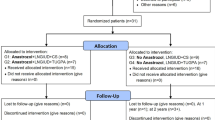Abstract
To assess the treatment efficacy of adenomyoma and improvement in implantation receptivity associated with the levonorgestrel-releasing intrauterine system (LNG-IUS) combined with adenomyoma resection. Fifty subjects (control group) underwent laparoscopic adenomyoma excision and received gonadotropin-releasing hormone (GnRH) agonists, and 201 subjects (experimental group) underwent laparoscopic adenomyoma resection and received GnRH agonists combined with the LNG-IUS. Pipelle endometrial biopsies were obtained in the mid-luteal phase, before the operation, and 19 months after the operation. Menstrual blood loss was measured using a pictorial blood loss assessment chart. Pain intensity during menstruation was evaluated on a 10-point visual analog scale (VAS). The volume of uterus was measured through ultrasound. Quantification of HOXA10 promoter methylation was performed through bisulfite sequencing polymerase chain reaction (BSP). Real-time polymerase chain reaction analyzed the expression levels of endometrial HOXA10-mRNA and leukemia inhibitory factor (LIF)-mRNA. After surgery, the scores for dysmenorrhea and menorrhagia were significantly improved, and the volume of the uterus was obviously reduced (all p < 0.01). The mean number of methylated CpG sites, level of endometrial HOXA10-mRNA, and level of endometrial LIF-mRNA were 5.6 ± 1.7 versus 3.9 ± 1.3, 0.8 ± 0.2 versus 0.9 ± 0.3, and 0.8 ± 0.2 versus 1.0 ± 0.2, respectively, in the control group versus the experimental group at 19 months after surgery, and significant improvements were observed in the experimental group (p < 0.001, p = 0.034, p < 0.001). Laparoscopic adenomyoma excision and GnRH agonists can alleviate the symptoms, reduce the number of methylated CpG sites in HOXA10, and improve endometrial HOXA10-mRNA and endometrial LIF-mRNA levels. When combined with subsequent use of the LNG-IUS, better efficacy can be achieved.
Similar content being viewed by others
References
Garcia L, Isaacson K. Adenomyosis: review of the literature. J Minim Invasive Gynecol. 2011;18(4):428–37.
Benagiano G, Brosens I. History of adenomyosis. Best Pract Res Clin Obstet Gynaecol. 2006;20(4):449–63.
Garavaglia E, Audrey S, Annalisa I, Stefano F, Iacopo T, et al. Adenomyosis and its impact on women fertility. Iran J Reprod Med. 2015;13(6):327–36.
Devlieger R, D’Hooghe T, Timmerman D. Uterine adenomyosis in the infertility clinic. Hum Reprod Update. 2003;19(2):139–47.
Huang HY, Chan SH, Wu JH, et al. Interleukin-I system mRNA and protein expression at the endometrial myometrial interface (EMI) of human uterine adenomyosis: possible pathophysiologic implications of endometriosis. Fertil Steril. 2004;82(2):318–20.
Fraser IS. Added health benefits of the levonorgestrel contraceptive intrauterine system and other hormonal contraceptive delivery systems. Contraception. 2013;87:273–9.
Koo YJ, Im KS, Kwon YS. Conservative surgical treatment combined with GnRH agonist in symptomatic uterine adenomyosis. Pak J Med Sci. 2011;27:365–70.
Taylor HS. The role of HOX genes in human implantation. Hum Reprod Update. 2000;6:75–9.
Taylor HS, Vanden Heuvel GB, Igarashi P. A conserved Hox axis in the mouse and human female reproductive system: late establishment and persistent adult expression of the Hoxa cluster genes. Biol Reprod. 1997;57:1338–45.
Kondera-Anasz Z, Sikora J, Mielczarek-Palacz A. Leukemia inhibitory factor: an important regulator of endometrial function. Am J Reprod Immunol. 2004;52:97–105.
Higham JM, O’Brien PMS, Shaw RW. Assessment of menstrual blood loss using a pictorial chart. Br J Obstet Gynaecol. 1990;97:734–9.
Johar P, Grover V, Topp R, Behm DG. A comparison of topical menthol to ice on pain, evoked tetanic and voluntary force during delayed onset muscle soreness. Int J Sports Phys Ther. 2012;7:314–22.
Wang PH, Su WH, Sheu BC, Liu WM. Adenomyosis and its variance: adenomyoma and female fertility. Taiwan J Obstet Gynecol. 2009;48:232–8.
Vercellini P, Consonni D, Dridi D, Bracco B, Frattaruolo MP, Somigliana E. Uterine adenomyosis and in vitro fertilization outcome: a systematic review and meta-analysis. Hum Reprod. 2014;29:964–77.
Takahashi K, Nagata H, Kitao M. Clinical usefulness of determination of estradiol level in the menstrual blood for patients with endometriosis. Nihon Sanka Fujinka Gakkai Zasshi. 1989;41:1849–50.
Tremellen KP, Russell P. The distribution of immune cells and macrophages in the endometrium of women with recurrent reproductive failure. II: adenomyosis and macrophages. J Reprod Immunol. 2012;93:58–63.
Taylor HS, Bagot C, Kardana A, Olive D, Arici A. HOX gene expression is altered in the endometrium of women with endometriosis. Hum Reprod. 1999b;14:1328–31.
Taylor HS, Arici A, Olive D, Igarashi P. HOXA10 is expressed in response to sex steroids at the time of implantation in the human endometrium. J Clin Invest. 1998;101:1379–84.
Taylor HS, Igarashi P, Olive D, Arici A. Sex steroids mediate HOXA11 expression in the human peri-implantation endometrium. J Clin Endocrinol Metab. 1999a;84:1129–35.
Gui Y, Zhang J, Yuan L, Lessey BA. Regulation of HOXA-10 and its expression in normal and abnormal endometrium. Mol Hum Reprod. 1999;5:866–73.
Wu Y, Halverson G, Basir Z, Strawn E, Yan P, Guo SW. Aberrant methylation at HOXA10 may be responsible for its aberrant expression in the endometrium of patients with endometriosis. Am J Obstet Gynecol. 2005;193:371–80.
Szczepanska M, Wirstlein P, Luczak M, Jagodzinski PP, Skrzypczak J. Reduced expression of HOXA10 in the midluteal endometrium from infertile women with minimal endometriosis. Biomed Pharmacother. 2010;64:697–705.
Funding
The author(s) disclosed receipt of the following financial support for the research, authorship, and/or publication of this article. This study was supported by the Fujian hygiene fund of youth research (Grant No. 2016-1-32).
Author information
Authors and Affiliations
Corresponding author
Ethics declarations
Ethical Statements
Ethics committee approval was obtained from the Institutional Ethics Committee of Fujian Provincial Hospital for the commencement of the study.
Conflict of Interest
The authors declare that they have no conflict of interest.
Additional information
Publisher’s Note
Springer Nature remains neutral with regard to jurisdictional claims in published maps and institutional affiliations.
Rights and permissions
About this article
Cite this article
Wu, Q., Lian, Y., Chen, L. et al. Alleviation of Symptoms and Improvement of Endometrial Receptivity Following Laparoscopic Adenomyoma Excision and Secondary Therapy with the Levonorgestrel-releasing Intrauterine System. Reprod. Sci. 27, 1259–1265 (2020). https://doi.org/10.1007/s43032-019-00130-4
Received:
Accepted:
Published:
Issue Date:
DOI: https://doi.org/10.1007/s43032-019-00130-4




